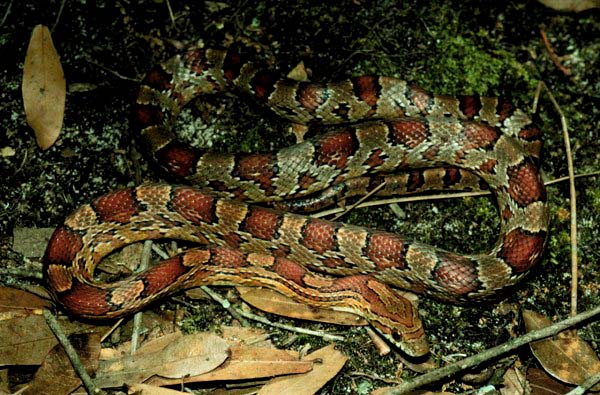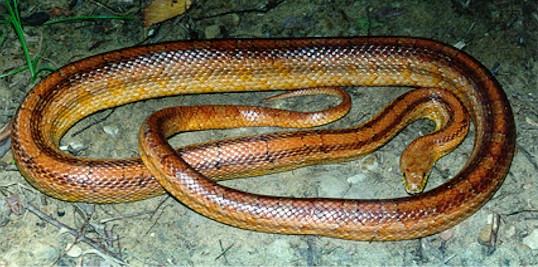
Elaphe guttata guttata (Cornsnake)

Photo by Troy Hibbitts

Photo by Terry Hibbitts
Written by Troy Hibbitts
Common Names: Cornsnake, Red Ratsnake
Scientific Name: Elaphe guttata guttata
Range: The Cornsnake ranges from New Jersey south to Key West, Florida along the Atlantic seaboard, west to the Mississippi River in the vicinity of New Orleans, and north to about Memphis, Tennessee. There exist several disjunct populations in Kentucky. Additionally, populations of this species in Central Louisiana, Eastern Texas, extreme Eastern Oklahoma, and Arkansas are sometimes referred to as this subspecies and sometimes as intergrades with E.g.emoryi, the Great Plains Ratsnake.
Habitat: The Cornsnake frequents upland, terrestrial habitats ranging from pinewood hammocks just above the swamps in Florida to rocky ridges in the Apalachians. It seems to favor relatively dry and exposed habitats throughout its range, particularly in places with subterranean mammal burrows. Its greatest abundance occurs in sandy pinewoods in the southeastern states.
Behavior: Active both day and night, depending largely upon temperature. The cornsnake often searches subterranean rodent burrows for prey. It is also a skilled climber, able to scale vertical pine trees by clinging to the rough bark surfaces of the tree. The cornsnake breeds in the spring - brumation is not required, but best breeding success follows a burmation period of about 3 months at 55 degrees fahrenheit. 8-20 eggs are laid in late May or early June with the eggs hatching in August or September. In many areas, hatchlings feed largely on lizards (particularly Anolis sp.), but usually will also take nestling rodents. Adults feed predominantly on rodents, but will take the occassional bird or bird egg.
Size: Hatchlings range from 8-14 inches in length, while adults range between 30 and 48 inches. The record was a 6 foot (72") giant.
Coloration:
Wild Types:
Cornsnakes vary widely in coloration, both within and between populations. Their basic pattern consists of 25 to 38 black bordered dorsal blotches, with a corresponding number of lateral blotches. The dorsal blotches are usually broader anteriorly. The color of the dorsal blotches ranges from brown to reddish brown through orange and bright red. The ground color ranges from silvery gray through bronzy browns to orange and red. The most consistent feature of the cornsnake's pattern is the classis "spearpoint" on the animal's head. Two broad bands from the first dorsal blotch of the nape extend forward onto the head and run to a point between the eyes, with a small, elongate blotch lying just between these bands. The ventral scales are boldly checkered with black squares on white background.
Several wild type cornsnakes have been given thier own names and one has been recognized at times as its own subspecies:
Rosy Ratsnake - cornsnakes from the lower Florida Keys are smaller, slimmer serpents than their mainland relatives. Generally thier coloration is characterized by much reduction in the amount of black pigment bordering the dorsal blotches and a loss of most of the black checkering typical of most corn's ventral surfaces. The ventral surfacess are also washed with rosy pinkish colors.
Miami phase - named for snakes found in the Miami area originally, this designation is now applied wholesale to wild-type corns which exhibit patterns similar to those original "Miami" specimens. A Miami phase corn typically has bright red blotches on a silvery background.
Oketee Corns - named for the Oketee Plantation in South Carolina, these corns are what most of us think about when we think cornsnake - a bright orange snake with bold, black bordered red blotches. However, not all corns from Oketee look like this, and not all corns that look like Oketees originate from South Carolina bloodlines.
Chocolate Corns - recently, snakes from Central Louisiana, East Texas, East Oklahoma, and Arkansas have been considered to be cornsnakes taxonomically rather than Great Plains Ratsnakes. In build, these snakes are shaped like corns, as is the shape of thier blotches, while in coloration, these animals are similar to Great Plains Ratsnakes. Typically, one of these animals will have a light to dark gray ground color with blotches ranging from rusty reddish brown to dark brown.
Captive Bred Cultivars:
There are more captive produced breeds of cornsnakes than any other species of reptile, and a discription of each of these exceeds the scope of this page. However, I will touch on a few of these:
Amelanistic - classic red albino cornsnakes lacking black pigment. The oldest of the captive bred strains of cornsnake. Sunglow and Candy Cane varieties are strains bred to reduce white and orange colors, respectively.
Anerythristic - snakes lacking red color altogether. Some wild Florida populations have a significant number of these present. Two varieties of anerythistic result from different genes. Type A has some yellow color present and Type B lacks the yellow as well as red.
Hypomelanistic - black is reduced but not lacking altogether, making a mostly red animal.
Motley - blotches are fused in an irregular fasion, by striping at the cornes or by joining lateral and dorsal blotches. Ventral pattern is lost altogether. Different allele of same gene results in striped.
Striped - perhaps the most bizzare cornsnake variety. Dorsal pattern consists of paired stripes running much of the length of the body. Ventral pattern is lost.
Bloodred - ground color and blotch color is the same, and black is more or less missing. Ventral checkering is missing.
Snow - combination of Amelanistic and Anerythristic genes
Ghost - combination of Hypomelanistic and Anerythristic genes.
Creamsicle - an Amelanistic cornsnake with a significant percentage of its heritage from the Great Plains Ratsnake. A captive produced intergrade. Colors usually yellow-orange instead of orange-red.
For more pictures and information regarding captive produced cultivars, try looking at the following sites: Serpenco and South Mountain Reptiles.